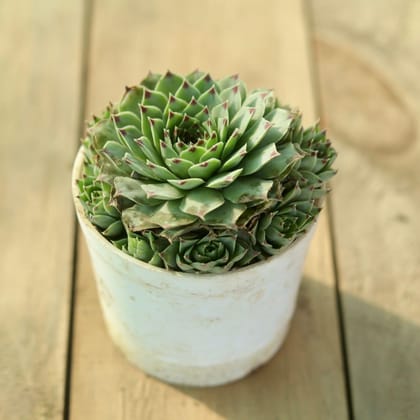Lakshmi Kamal / Sempervivum Succulent plant in 3 Inch Nursery Pot
Lakshmi Kamal / Sempervivum Succulent plant in 3 Inch Nursery Pot
Share
Lakshmi Kamal (Aloe vera 'Lakshmi Kamal') is a succulent plant native to India and Africa. It belongs to the Asphodelaceae family and is known for its thick, fleshy leaves and vibrant, orange-red flowers.
Climate Requirements
1. *Temperature*: Lakshmi Kamal plants prefer temperatures between 65°F (18°C) and 90°F (32°C).
2. *Humidity*: They thrive in dry environments, typically below 50% relative humidity.
3. *Sunlight*: Provide full sun to partial shade, depending on the climate.
Watering Requirements
1. *Infrequent watering*: Water Lakshmi Kamal plants sparingly, allowing the soil to dry out completely between waterings.
2. *Well-draining soil*: Ensure the soil drains well to prevent root rot.
3. *Drought tolerance*: Lakshmi Kamal plants are highly drought-tolerant, but consistent moisture promotes healthy growth.
Medicinal Uses
1. *Skin care*: Lakshmi Kamal plants have been used in traditional medicine to treat skin conditions like eczema, acne, and burns.
2. *Digestive aid*: The plant's gel has anti-inflammatory properties that may help soothe digestive issues like irritable bowel syndrome.
3. *Antibacterial properties*: Lakshmi Kamal plants have antibacterial properties that can help prevent infection.
Fertilizing Requirements
1. *Balanced fertilizer*: Feed Lakshmi Kamal plants with a balanced, water-soluble fertilizer during the growing season (spring and summer).
2. *High-potassium fertilizer*: Use a high-potassium fertilizer to promote healthy root growth and flowering.
Composting Requirements
1. *Compost tea*: Use compost tea as a foliar spray to promote healthy growth and prevent diseases.
2. *Mulching*: Mulch around the base of the plant to retain moisture and suppress weeds.
Caring Methods
1. *Pruning*: Prune Lakshmi Kamal plants regularly to maintain their shape, promote new growth, and encourage healthy foliage.
2. *Pest control*: Monitor for pests like mealybugs, spider mites, and scale, and treat promptly if necessary.
3. *Repotting*: Repot Lakshmi Kamal plants every 2-3 years to refresh the soil and provide a larger pot if necessary.
Planting Methods
1. *Stem cuttings*: Propagate Lakshmi Kamal plants using stem cuttings, which can be rooted in water or soil.
2. *Nursery-grown plants*: Plant nursery-grown Lakshmi Kamal plants in well-draining soil, providing full sun to partial shade.
3. *Transplanting*: Transplant established Lakshmi Kamal plants carefully, avoiding root disturbance and providing sufficient water.
Common Problems and Solutions
1. *Root rot*: Caused by overwatering, treat by reducing watering frequency and improving soil drainage.
2. *Pests*: Treat infestations promptly with insecticidal soap or neem oil.
3. *Nutrient deficiencies*: Fertilize regularly, and consider adding micronutrients like iron or magnesium if necessary.
Interesting Facts
1. *Air-purifying abilities*: Lakshmi Kamal plants are known to purify the air by removing toxins and pollutants.
2. *Low-maintenance*: Lakshmi Kamal plants are relatively low-maintenance and can thrive in indoor conditions with minimal care.
3. *Ornamental value*: Lakshmi Kamal plants are valued for their vibrant, orange-red flowers and are often used in ornamental gardens and indoor spaces.
By following these guidelines and understanding the specific needs of your Lakshmi Kamal succulent plant, you'll be well on your way to growing a healthy and thriving plant that provides numerous benefits for medicinal uses, air purification, and ornamental value.


